This review is my personal experience and opinion on the reports offered with Dante Labs’ whole-genome sequencing. More to come at a later date on how to use the whole-genome data files…
Dante Labs Whole Genome Sequencing Reports
Dante Labs offers whole-genome sequencing at a relatively low price point. A whole-genome sequence looks at all of your nuclear DNA, which is different than 23andMe or AncestryDNA, which looks at a small portion of your DNA (<1%).
Customer Support and Ordering time:
I initially contacted Dante Labs via their website contact form in October, asking some fairly specific questions and explaining that I may decide at some point to write an article about their product. The response that I got several days later was very vague, didn’t answer my questions and included parts of their website copy just pasted into the email. I chalked it up to either a language barrier or perhaps outsourcing their contact form requests. I’m sure they get a lot of inquiries from potential customers.
I went ahead and ordered the full genome sequencing – 30X coverage – when it was on sale for Black Friday. At $189, that was a deal that I couldn’t pass up, so I ordered the kit via Amazon. The regular price for the 30x coverage is $599 for an 8-week turnaround time.
Within the 8 week timeframe, I had my results. There had been problems in the past with Dante Labs having delays with getting their orders fulfilled, but that doesn’t seem to be the case now (at least for me.)
Ordering Process:
The process of completing the test was similar to other genetic testing companies. You spit in a tube, seal it up, and mail it off. On the Dante Labs website, you have to create an account to register the sample. Unfortunately, the directions on the instruction card included with the kit didn’t match up with how to do it on the website. But after some poking around on the site, I figured out how to create another type of account to register the sample (if anyone else is struggling with this, go to genome.dantelabs.com, not dantelabs.com/acount, as it says in the instructions).
Within your account on Dante Labs, there is an update section that tells you where your sample is in the sequencing process. When I checked after three weeks, the sample did not show it had been received. Oh, no! I contacted customer service and found out that they don’t update this section until they receive the sample from their lab in Europe. Since I had mailed mine from the US, the sample was held at a storage facility before being shipped to their lab after about 5 or 6 weeks. About six weeks after I shipped my sample, I did get an email from Dante Labs saying that they had received it.
Privacy Policy:
Do read through the privacy policy and make sure you are ok with it before ordering a test kit. They do state that they keep your information for 10 years. The privacy policy also states that you can request that your saliva sample be destroyed after processing, but I can’t find that option anywhere within my account settings. Perhaps that option is available if you contact them.
What’s Included in the Dante Labs 30x WGS:
Included with the full genome test were two reports – a Wellness and Lifestyle report and a Nutrigenomics report. There are also 36 more reports that you can purchase, most around $49 each, or a group package of all reports for $499. Oddly enough, some of these reports that you can order for an extra $49 seem to be on topics that are already covered in the Wellness and Lifestyle report, but perhaps they contain further information.
Also included are the full genome sequencing files in various formats including VCF, BAM, and FASTQ formats. (I’ll have lots more on using the full genome files in a future article.)
Dante Labs Wellness and Lifestyle report:
Looking at my Wellness and Lifestyle report, it states that it analyzes 70 health conditions. These ranged from Alpha-1 antitrypsin deficiency to Leigh syndrome to Marfan syndrome. All of these conditions are ones that are covered in ClinVar. Thus, this report is basically matching up the mutations for 70 conditions in ClinVar, which is the database repository containing information on thousands of hereditary disease mutations.
My results and thoughts on the Wellness and Lifestyle report information:
Two things popped up for me on this report, both of which I already knew from my 23andMe and AncestryDNA data. These were both listed as “High Risk” conditions.
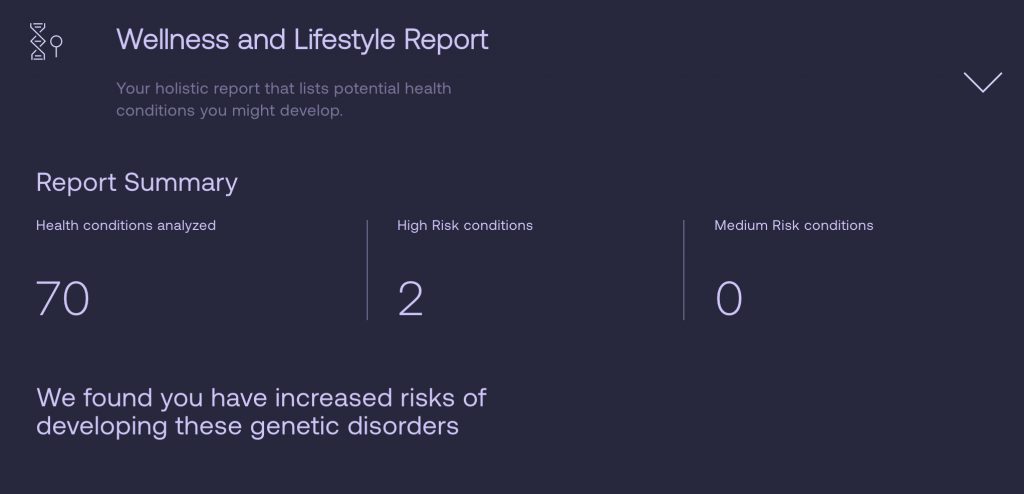
The first thing that popped up was that I carry a genetic variant related to hemochromatosis. The online report first lists a general description of the variant location: “We have found a heterozygous variant associated with Hereditary Hemochromatosis in the HFE|LOC108783645 gene. Your genetic makeup evidences a nucleotide change from a C to a G in the DNA. This variant is present on one copy of chromosome 6 in position 26091179.” This is followed by a general explanation of hemochromatosis.
Advice and Actions section was about a different mutation:
Next up in the hemochromatosis report was an “Actions and Advice” section stating that I’m at an increased risk of developing hemochromatosis and should talk with my healthcare provider. That was followed by specific advice from the European Association for the Study of the Liver. The problem here is that the specific advice was for people carrying the HFE Cys282Try (C282Y) mutation…
Nowhere on the report does it mention that I carry the HFE H63D variant, which is not the mutation for which the Actions and Advice section refers. This could be really confusing for most people since the mutation that the advice is for (C282Y) causes a much greater risk for hemochromatosis and iron-related health problems. The variant that I actually carry, the H63D variant, is not mentioned anywhere in the Advice and Actions section.
Common variants vs. rare mutations:
More than 25% of Caucasians carry one copy of the HFE H63D variant, like me. One copy of this variant is unlikely to cause hemochromatosis. Nowhere does the Dante Labs report explain that the risk for the HFE H63D variant is either for people with two copies of the variant or for one copy in conjunction with the HFE C282Y mutation. The report also doesn’t mention that the variant that I carry is fairly common.
The second genetic variant that showed up on my report is a variant that increases the risk of age-related macular degeneration. Again, nowhere in the report does it indicate that this variant is fairly common, with around half of most population groups carrying at least one copy of the variant.
In contrast, almost all of the other mutations included in the Wellness report are much less common. It would be nice if the Wellness report could convey the difference between carrying a variant that half the world carries (for macular degeneration) vs the rare cancer-causing mutations, such as the mutations listed for Li-Fraumeni syndrome.
Copied and pasted report text from other sources without citing the sources:
The “About” section text for most of the 70 conditions in the report is cut-and-pasted from the Genetics Home Reference website. It is simply copied, word for word, without a link back or any indication as to where the information came from… Yes, this may be technically legal and not a copyright violation since the Genetic Home Reference website is a US government website.
The ‘Actions and Advice’ section, at least for a number of reports that I checked, is cut-and-pasted from the GeneReviews, which is an online book available via the NIH website. The book is copyrighted to the University of Washington, which grants reprint permission only for non-commercial and research purposes and requires crediting the source. This source is not credited on either the online report nor in the downloadable .pdf report.
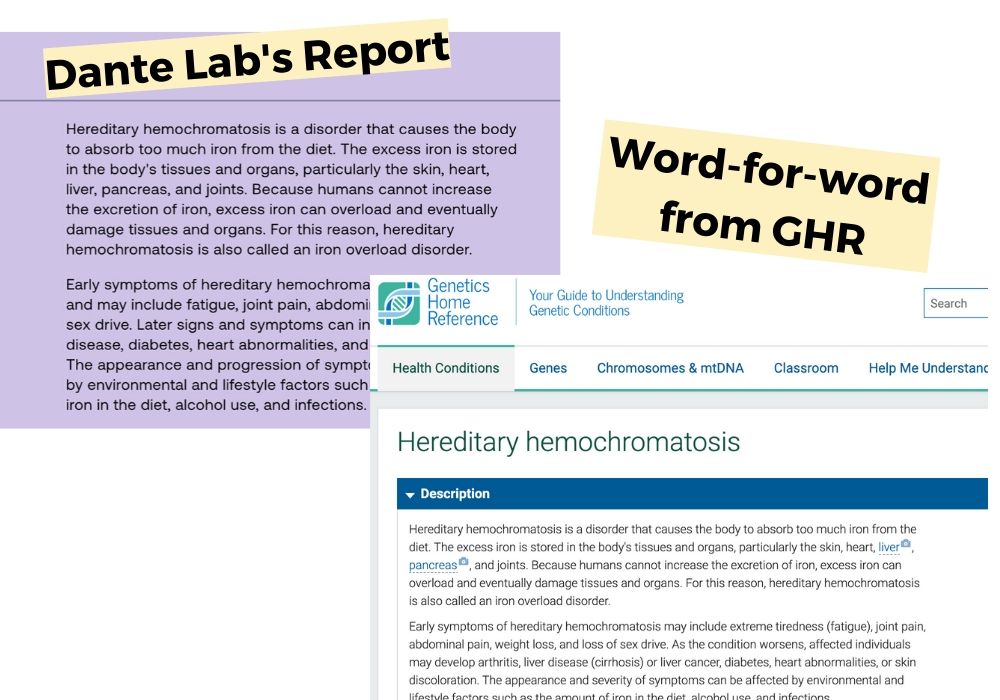
Yes, I’m being a stickler here with my criticism of the copied text without crediting the sources for the ‘About’ and ‘Actions and Advice’ sections. This, to me, is an important integrity-related issue.
I’m at a high risk for every single terrible genetic disease covered?
I also clicked around in the “no variants detected” section of the online Wellness report to find out exactly which mutations they were screening for (not given). I started off by clicking on the hereditary cancers and was a bit startled to find that in the Actions and Advice section that it states that my genotype suggests that I am at an increased risk for Pilomatrixoma… and then all of the other hereditary cancers – as well as all of the rest of 70 different hereditary diseases. Wow! That is pretty amazing that my genotype puts me at an increased risk for all of those devastating diseases.
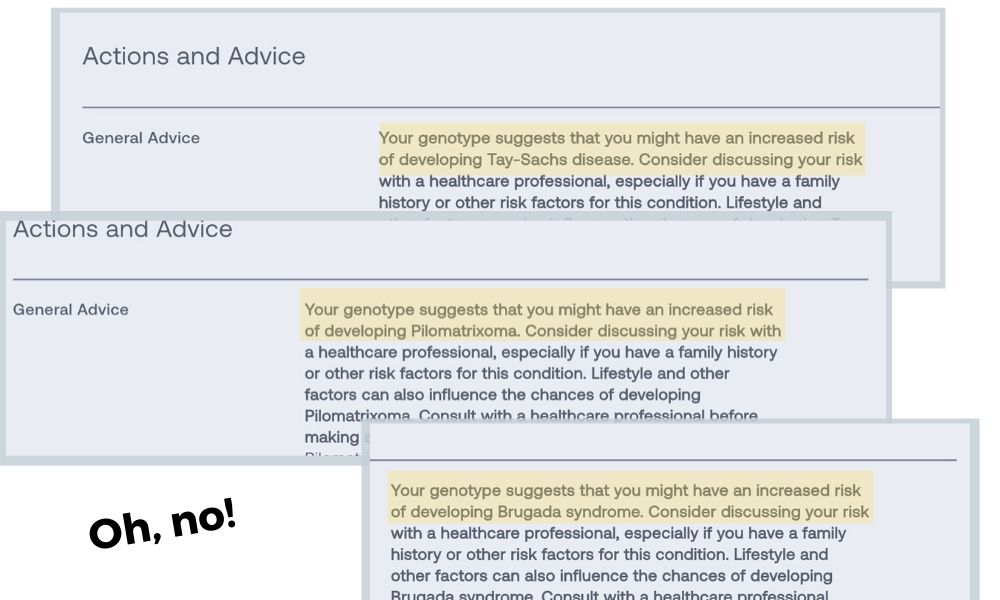
Yes – they have an error in their system that is showing the wrong text for people who don’t carry the disease. I don’t actually have 70 different genetic diseases.
I get that errors happen – trust me, I get that. But telling everyone that they are at an increased risk for all kinds of terrible diseases seems like an error that someone in the company should have caught by now. Hopefully, they will get this fixed soon!
Dante Labs Nutrigenomics Report:
Also included is a Nutrigenomics report that summarizes 23 health conditions.
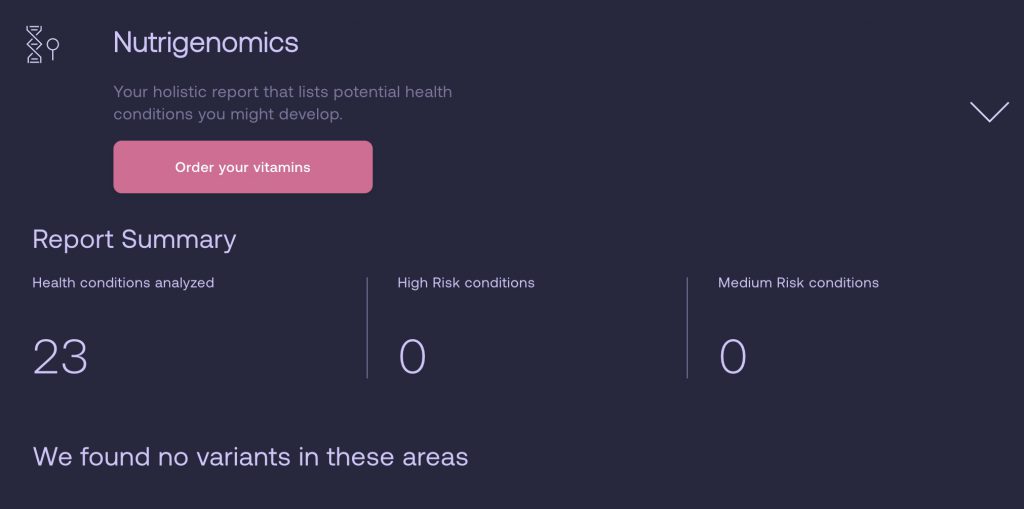
The button to “Order your vitamins” doesn’t actually work. It takes me to a blank page… Perhaps this is a feature that is coming in the future?
None of the categories on the report indicate that I have any problems. Yay, me! According to the online report, I have no variants at all that impact nutrition.
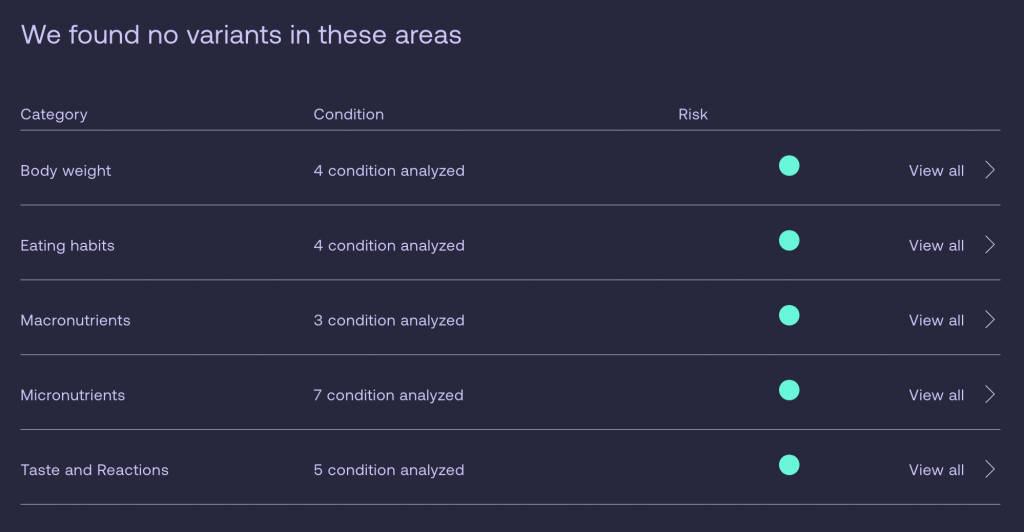
Let’s dig a little deeper… I’m green for no variants in the Obesity category. Click on it brings me to a description of obesity and an Actions and Advice section. The Actions and Advice section explains that the genetic predisposition to obesity is based on my genotypes for the FTO and MC4R variants. You may assume since I don’t have an increased risk indicated that I’m all clear here. But I know from my genetic data that I carry multiple FTO and MC4R variants that put me at a higher risk for obesity, so I’m really confused by this section.
The metabolism section is also ‘Green’ for me, but this section makes even less sense. 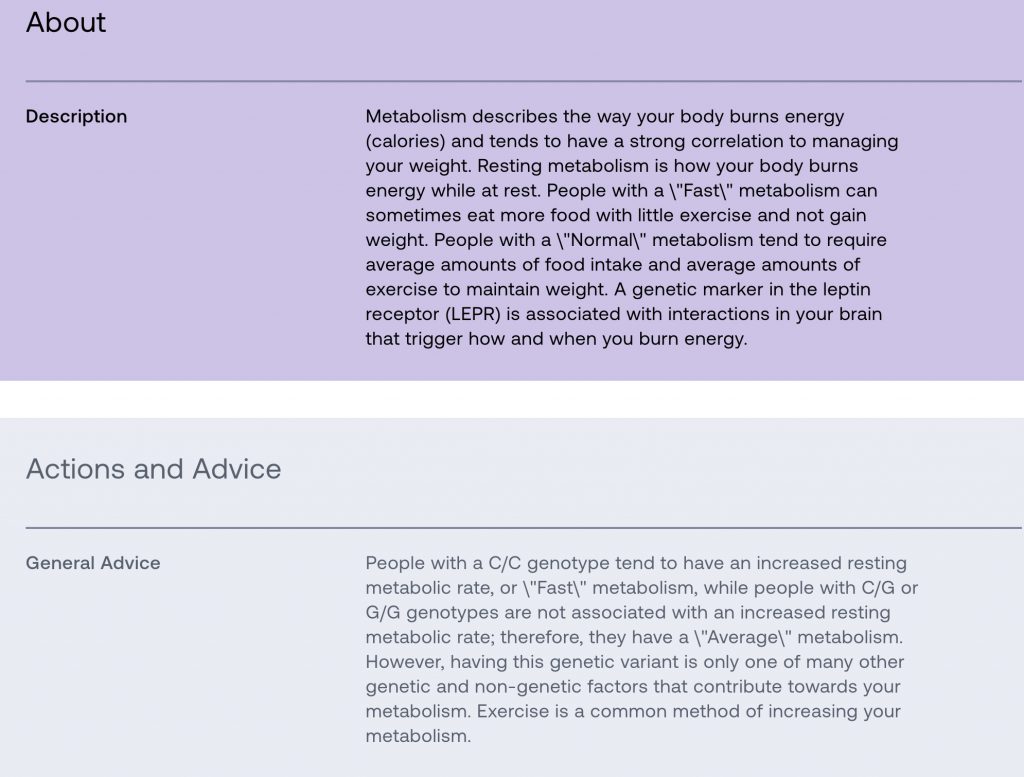
Nowhere in the online report for weight or metabolism does it show which genetic markers the report is looking at — or what my genotype is for those markers. Everything just shows that I am ‘green’ and have no variants.
Incorrect Nutrigenomics Information:
This pattern continues through the rest of the nutrigenomics online report, showing that I’m green and don’t carry any genetic variants for any of the nutritional components of the Dante Labs Nutrigenomics report. This would be great if it were accurate. But I know from my genetic data that I actually carry several of the different variants that they are covering in their report…
I clicked to download the printable Nutrigenomics report and found that my genetic risk information in the printable report was different than what was shown on the online report. For example, the online report showed me as being ‘green’ with no problems in the omega-6 and omega-3 area, but the printable report explains that I do carry the variants that decrease EPA and AA levels.
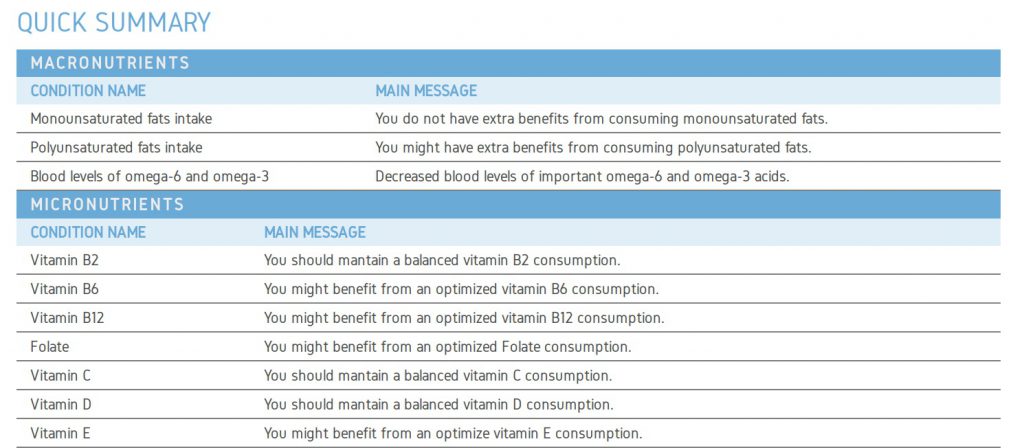

Printable reports:
There are printable versions of the two reports available, which is a nice feature. The printable version of the report has a general ‘Limitations’ section including the fact that “This is not intended for US people and as such it has not been reviewed and approved by FDA”. I thought it was interesting that I hadn’t seen that wording anywhere else when ordering the test from the US. Maybe I missed it, though.
The printable version of the report showed an overview of each condition and a green checkmark or red minus sign to indicate the results.
For the Wellness and Lifestyle report, the same information as was in the online report was listed for just the two variants that were detected for me. Again – my irritation here is that the Advice section for the hemochromatosis mutation is not about the variant that I carry, which is not indicated or made clear anywhere on the report. The printable version of the report also does not cite any sources of the information nor does it credit the GeneReviews website from which the information was copied.
No references – anywhere – to studies or the source of information:
I’m one of those people who likes to ‘check the references’. I do this in part to weigh the evidence for myself, and I also like to read more on a topic that interests me. Dante Labs reports include no references to the sources of their information that I can find anywhere within the reports section of the website nor on the printable reports.
Overall:
If I were just purchasing the Dante Labs whole genome test for these reports, I would be disappointed in the errors in the online Wellness report and in the contradictions between the online report and printable Nutrigenomics report.
But… I didn’t purchase the whole-genome sequencing for the reports, and I bet that a lot of people are in this same position. I bought the test to get access to the whole-genome data, which I’m downloading and playing with now.
To sum this up with some positives:
The test results came back on time and there is an easy option for downloading the data files in multiple file formats.
